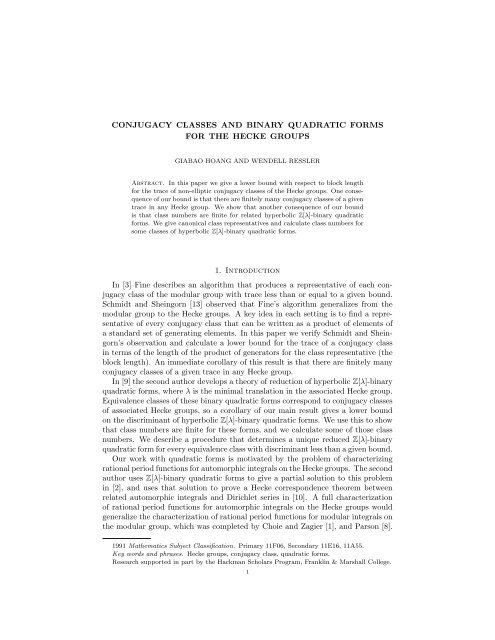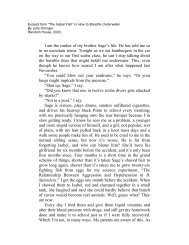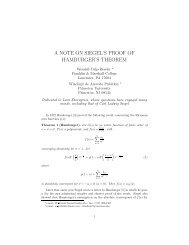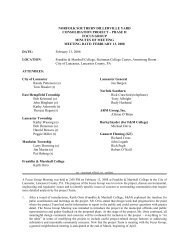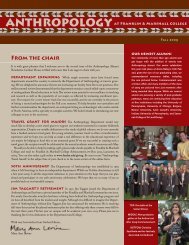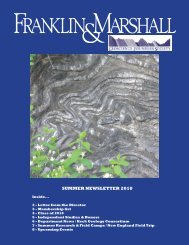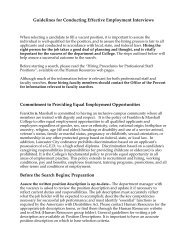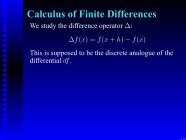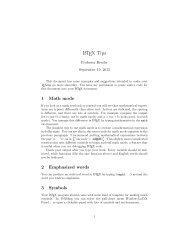CONJUGACY CLASSES AND BINARY QUADRATIC FORMS FOR ...
CONJUGACY CLASSES AND BINARY QUADRATIC FORMS FOR ...
CONJUGACY CLASSES AND BINARY QUADRATIC FORMS FOR ...
Create successful ePaper yourself
Turn your PDF publications into a flip-book with our unique Google optimized e-Paper software.
<strong>CONJUGACY</strong> <strong>CLASSES</strong> <strong>AND</strong> <strong>BINARY</strong> <strong>QUADRATIC</strong> <strong><strong>FOR</strong>MS</strong><strong>FOR</strong> THE HECKE GROUPSGIABAO HOANG <strong>AND</strong> WENDELL RESSLERAbstract. In this paper we give a lower bound with respect to block lengthfor the trace of non-elliptic conjugacy classes of the Hecke groups. One consequenceof our bound is that there are finitely many conjugacy classes of a giventrace in any Hecke group. We show that another consequence of our boundis that class numbers are finite for related hyperbolic Z[λ]-binary quadraticforms. We give canonical class representatives and calculate class numbers forsome classes of hyperbolic Z[λ]-binary quadratic forms.1. IntroductionIn [3] Fine describes an algorithm that produces a representative of each conjugacyclass of the modular group with trace less than or equal to a given bound.Schmidt and Sheingorn [13] observed that Fine’s algorithm generalizes from themodular group to the Hecke groups. A key idea in each setting is to find a representativeof every conjugacy class that can be written as a product of elements ofa standard set of generating elements. In this paper we verify Schmidt and Sheingorn’sobservation and calculate a lower bound for the trace of a conjugacy classin terms of the length of the product of generators for the class representative (theblock length). An immediate corollary of this result is that there are finitely manyconjugacy classes of a given trace in any Hecke group.In [9] the second author develops a theory of reduction of hyperbolic Z[λ]-binaryquadratic forms, where λ is the minimal translation in the associated Hecke group.Equivalence classes of these binary quadratic forms correspond to conjugacy classesof associated Hecke groups, so a corollary of our main result gives a lower boundon the discriminant of hyperbolic Z[λ]-binary quadratic forms. We use this to showthat class numbers are finite for these forms, and we calculate some of those classnumbers. We describe a procedure that determines a unique reduced Z[λ]-binaryquadratic form for every equivalence class with discriminant less than a given bound.Our work with quadratic forms is motivated by the problem of characterizingrational period functions for automorphic integrals on the Hecke groups. The secondauthor uses Z[λ]-binary quadratic forms to give a partial solution to this problemin [2], and uses that solution to prove a Hecke correspondence theorem betweenrelated automorphic integrals and Dirichlet series in [10]. A full characterizationof rational period functions for automorphic integrals on the Hecke groups wouldgeneralize the characterization of rational period functions for modular integrals onthe modular group, which was completed by Choie and Zagier [1], and Parson [8].1991 Mathematics Subject Classification. Primary 11F06, Secondary 11E16, 11A55.Key words and phrases. Hecke groups, conjugacy class, quadratic forms.Research supported in part by the Hackman Scholars Program, Franklin & Marshall College.1
2 GIABAO HOANG <strong>AND</strong> WENDELL RESSLERThe Choie–Zagier–Parson result uses properties of classical quadratic forms, whichcorrespond to elements of the modular group as described in [14].In section 2 we give background definitions and facts about the Hecke groupsand related continued fractions and binary quadratic forms. In section 3 we presentresults about conjugacy classes in Hecke groups, including the lower bound that isour main result, Theorem 3.6. In section 4 we apply our result to the problem ofclass numbers for hyperbolic Z[λ]-binary quadratic forms.2. Background( ) 1 λ2.1. Hecke groups. Let λ be a positive real number, and put S = S λ = ,0 1( ) ( )0 −11 0T = , and I = . The Hecke groups are the groups G p = G(λ p ) =1 00 1〈S λ , T 〉/{±I} ⊆ PSL(2, R), where λ = λ p = 2 cos(π/p), for p ≥ 3 is an integer.Erich Hecke showed that these values of λ are the only ones between 0 and 2 forwhich G(λ) is discrete [4]. (If λ ≥ 2, then G(λ) is discrete but has a simpler groupstructure.)Throughout this paper we fix the integer p ≥ 3 and the positive real numberλ = λ p = 2 cos(π/p).The Hecke groups are projective matrix groups, so they are isomorphic to groupsof linear fractional transformations. We will use both ways of thinking about groupelements. Elements of G p have entries in Z[λ p ], so G p is a subgroup of PSL(2, Z[λ p ]).One of the Hecke groups is the modular group G 3 = PSL(2, Z), however G p PSL(2, Z[λ p ]) for p > 3.( ) λ −1Let U = ST = . For each p ≥ 3, G p has the group relations T 2 =1 0U p = I. Each Hecke group G p is the free product of the cyclic group of order pgenerated by U, and the cyclic group of order 2 generated by T .We let Tr(M) denote the trace of M ∈ G p . An element M ∈ G p is hyperbolic if|Tr(M)| > 2, parabolic if |Tr(M)| = 2, and elliptic if |Tr(M)| < 2.Because G p is discrete, the stabilizer of any complex number z in G p , stab(z) ={M ∈ G p | Mz = z} is a cyclic subgroup of G p [5]. Thus the fixed point sets of anytwo nontrivial elements of G p are identical or disjoint, and all nontrivial elementsof a stabilizer have identical fixed points. We designate fixed points as hyperbolic,parabolic, or elliptic according to the elements fixing them. Hyperbolic elementshave two real fixed points, one attracting and one repelling. Parabolic elementshave a single real fixed point, and elliptic elements have two complex conjugatefixed points. We say that an element is primitive if it generates the stabilizer ofeach of its fixed points.We will always take the trace to be positive, which we may do because theHecke groups are projective. Trace is invariant under conjugation, so elements of aconjugacy class in G p all have the same trace and all have the same designation ashyperbolic, parabolic, or elliptic.We say that complex numbers z 1 and z 2 are G p -equivalent if there exists M ∈ G psuch that Mz 1 = z 2 . G p -equivalence is an equivalence relation, so G p partitionscomplex numbers into equivalence classes. Two fixed points are G p -equivalent ifand only if the linear fractional transformations fixing them are conjugate to each
<strong>CONJUGACY</strong> <strong>CLASSES</strong> <strong>AND</strong> <strong>BINARY</strong> <strong>QUADRATIC</strong> <strong><strong>FOR</strong>MS</strong> 3other in G p . Thus equivalence classes of numbers contain either all fixed points ofthe same kind, or no fixed points.2.2. λ-continued fractions. We will use a modification of Rosen’s continued fractions[11], which are closely associated with the Hecke groups.For real α we put α 0 = α and define r j = [ α j]λ + 1 and1αj+1 =r jλ−α jforj ≥ 0. Then α j = r j λ − 11α j+1for j ≥ 0 and α = r 0 λ − = [r. 0 ; r 1 , . . . ] is..r 1λ−the λ p -continued fraction (λ p -CF or λ-CF) for α. An admissible λ-CF is one thatarises from a finite real number by this algorithm.An admissible λ p -CF has at most p − 3 consecutive ones in any position but thebeginning, and has at most p − 2 consecutive ones at the beginning [9]. Schmidtand Sheingorn [13] show that a real number is a fixed point of G p if and only if ithas a periodic λ-CF; the number is parabolic if its λ p -CF has period [2, 1, . . . , 1],} {{ }p−3and hyperbolic if its λ p -CF has any other period.2.3. Z[λ]-binary quadratic forms. We consider indefinite binary quadratic forms(λ p -BQFs or λ-BQFs) Q(x, y) = Ax 2 +Bxy+Cy 2 of discriminant D = B 2 −4AC >0, where A, B, C ∈ Z[λ]. We also denote each λ-BQF Q(x, y) by Q = [A, B, C].Elements of the corresponding Hecke group act on λ-BQFs by (Q ◦ M) (x, y) =( ) a bQ(ax + by, cx + dy) for M = ∈ G p . This action preserves discriminants.c dWe say that two λ-BQFs Q and Q ′ are G p -equivalent, and write Q ∼ Q ′ , if thereexists a V ∈ G p such that Q ′ = Q ◦ V . This is an equivalence relation, so G ppartitions the λ-BQFs into equivalence classes of forms of the same discriminant.2.4. Matrices, forms, and fixed points. A key tool in [9] is an explicit isomorphismbetween primitive, hyperbolic elements of G p , certain indefinite λ-BQFs, andhyperbolic fixed points.Under that isomorphism a primitive hyperbolic element (which we take to have( ) a bpositive trace) M = ∈ G p corresponds to the indefinite form ρ(M) =c dQ M = [c, d − a, −b] with discriminant D = (a + d) 2 − 4. Images of hyperbolicelements of G p are indefinite forms. We say that the forms in the range of ρ arehyperbolic λ-BQFs. Two hyperbolic λ-BQFs are G p -equivalent if and only if thecorresponding elements of G p are conjugate to each other. Thus λ-BQFs in therange of ρ are in equivalence classes that correspond to conjugacy classes in G p .The second part of the isomorphism in [9] associates the hyperbolic form Q =[A, B, C] with discriminant D to the real number σ(Q) = α Q = −B+√ D2A. Theassociated matrix M = (σ ◦ ρ) −1 (α) is primitive, hyperbolic, and has α as anattracting fixed point [9, Lemma 4].This isomorphism includes all hyperbolic fixed points. If M ∈ G p is hyperbolicand ρ(M) = Q M = [A, B, C] and σ(Q M ) = α = −B+√ D2A, then M −1 is alsohyperbolic and ρ(M −1 ) = −Q M = [−A, −B, −C] and σ(−Q M ) = α ′ = −B−√ D2A.The fixed point α ′ is repelling for M but attracting for M −1 . We call α ′ the Heckeconjugate of α.
4 GIABAO HOANG <strong>AND</strong> WENDELL RESSLEREquivalence classes of hyperbolic fixed points correspond to conjugacy classes ofcorresponding matrices, as well as to equivalence classes of hyperbolic λ-BQFs.We can use λ-continued fractions to make explicit the map τ = (σ ◦ ρ) −1 fromhyperbolic fixed points to primitive hyperbolic elements of G p . The following lemmais Lemma 6 in [9].Lemma 2.1. Fix p ≥ 3 and λ = λ p = 2 cos(π/p). Suppose thatα = [r 0 ; r 1 , . . . , r n , r n+1 , . . . , r n+m ]is a hyperbolic fixed point of G p . Then the corresponding primitive linear fractionaltransformation is given by τ(α) = RP R −1 , where R = S r0 T S r1 T · · · S rn T andP = S rn+1 T S rn+2 T · · · S rn+m T .We could extend this isomorphism to include primitive parabolic elements of G p ,certain semidefinite λ-BQFs, and parabolic fixed points, but we will not need thatfor our purposes. In this paper we will only consider λ-BQFs that are hyperbolicaccording to this isomorphism.2.5. Reduction of λ-BQFs. The theory of reduction of hyperbolic Z[λ]-binaryquadratic forms in [9] uses λ-CFs and the isomorphism between primitive hyperbolicelements of G p , hyperbolic indefinite λ-BQFs, and hyperbolic fixed points.We say that a real number α is a G p -reduced number if the λ p -CF expansionof α is purely periodic with period other than [2, 1, . . . , 1]. A G} {{ } p -reduced numberp−3α is hyperbolic, and we say that the associated hyperbolic λ-BQF is G p -reduced.Every hyperbolic equivalance class of λ-BQFs contains finitely many reduced formsthat correspond to the cyclic permutations of the associated λ-CF period. Thusthe reduced λ-BQFs in a hyperbolic equivalence class comprise a cycle.3. Conjugacy classes in Hecke groupsFine shows in [3] that the non-elliptic conjugacy classes in Γ(1) each have arepresentative that is a cyclically reduced word in S and ST S. Fine uses this to givea lower bound for trace in terms of the “block length” of these products. Schmidtand Sheingorn [13] observe that Fine’s algorithm generalizes to the Hecke group G p ,( ) λ −1using the generators V j = U j−1 S for 1 ≤ j ≤ p−1, where U = ST = . We1 0first show that every conjugacy class in G p has a representative that is a productof these V j .Lemma 3.1. Fix p ≥ 3, put λ = λ p , and let V j = U j−1 S for 1 ≤ j ≤ p − 1. Thenevery non-elliptic element M ∈ G p is conjugate in G p to a product of the V j , thatis, M is conjugate toW = V j1 V j2 · · · V jt ,where 1 ≤ j k ≤ p − 1 for 1 ≤ k ≤ t, and t ∈ Z + . This product is unique, except forcyclic permutations.Proof. We first suppose that M ∈ G p is hyperbolic and let α be its attracting fixedpoint. Then α has a periodic λ-CF expansion of the formα = [r 0 ; r 1 , . . . , r n , r n+1 , . . . , r n+m ],
<strong>CONJUGACY</strong> <strong>CLASSES</strong> <strong>AND</strong> <strong>BINARY</strong> <strong>QUADRATIC</strong> <strong><strong>FOR</strong>MS</strong> 5where the period is not [2, 1, . . . , 1]. If M is primitive we have by Lemma 2.1 that} {{ }p−3M is conjugate to P = S rn+1 T S rn+2 T · · · S rn+m T . We let r a1 , r a2 , . . . , r aq be theentries in the period [r n+1 , . . . , r n+m ] that are greater than 1; we let b 0 be thenumber of leading ones and we let b k be the number of consecutive ones followingr k for 1 ≤ k ≤ q. ThenP = (ST ) b0 S ra 1 T (ST )b 1S ra 2 T (ST )b2· · · S raq T (ST ) bq .The restrictions on the number of consecutive ones in an admissible λ-CF [9, Lemma3] mean that b k ≤ p − 3 for 1 ≤ k ≤ q − 1 and b 0 + b q ≤ p − 3. We calculate thatP is conjugate toW = ( (ST ) b0 S ) −1P((ST )b 0S )(3.1)= S ra 1 −1 T (ST ) b1 S ra 2 T (ST )b2· · · S raq T (ST ) b0+bq S= S ra 1 −2 (ST ) b1+1 S · S ra 2 −2 (ST ) b2+1 S · · · S raq −2 (ST ) b0+bq+1 S= V ra 1 −21 V b1+2V ra 2 −2raq −21 V b2+2 · · · V1 V b0+b q+2,so M is conjugate to W . We note that 2 ≤ b k + 2 ≤ p − 1 for 1 ≤ k ≤ q − 1 and2 ≤ b 0 + b q + 2 ≤ p − 1, so W is a product of the V j , 1 ≤ j ≤ p − 1.Next we suppose that M ∈ G p is parabolic. If M fixes ∞, and if M is primitive,then M = S or M = S −1 . But S = V 1 and S −1 is conjugate to V p−1 = T S −1 T , soin either case M is conjugate to one of the V j .If the fixed point of a parabolic M is a finite number β, then β has a periodicλ-CF expansion of the form [13, Lemma 3]β = [r 0 ; r 1 , . . . , r n , 2, 1, . . . , 1].} {{ }p−3If M is primitive we have that M is conjugate to P = S 2 T (ST ) p−3 , and we calculatethat P is conjugate toW = S −1 P S= (ST ) p−2 S= V p−1 ,so M is conjugate to W .If a non-elliptic element M is not primitive, then M = R k where k is a positiveinteger and R ∈ G p is primitive. Then R is conjugate to a product of the V j asabove, which implies that M is also conjugate to a product of the V j , which is ktimes as long.The uniqueness follows from the fact that G p is the free product of 〈U〉 and 〈T 〉.This implies that the product is unique up to cyclic permutation. [6, Theorem1.4] □We are ready to formally define the idea of “block length” in this context.Definition 3.2. Fix p ≥ 3 and put λ = λ p . If W = V j1 V j2 · · · V jt where V j = U j−1 Sfor 1 ≤ j ≤ p − 1 we say that W has block length t.We need to know several things about the entries of the V j for 1 ≤ j ≤ p − 1.We will state an alternative version of Lemma 10 in [13], and give our own proof.
6 GIABAO HOANG <strong>AND</strong> WENDELL RESSLERLemma 3.3. Fix p ≥ 3 and put λ = λ p . Let V j = U j−1 S and put a j = sin(jπ/p)sin(π/p)for j ∈ Z. Then for j ∈ Z we have(i) a j = λa j−1 − a j−2 ,( )aj a(ii) V j =j+1,a j−1 a j(iii) a 1 = a p−1 = 1, and(iv) a j ≥ λ for 2 ≤ j ≤ p − 2.Proof. We use the well-known fact [7, 12] that powers of U satisfy(3.2) U j =( )aj+1 −a j,a j −a j−1for j ∈ Z + . In fact, it is easy to show that (3.2) holds for all integers j. ThenU j = U j−1 U( ) ( )aj −a=j−1 λ −1a j−1 −a j−2 1 0( )aj λ − a=j−1 −a j,a j−1 λ − a j−2 −a j−1so a j = λa j−1 − a j−2 , which is (i).For (ii) we calculate thatV j = U j−1 S( ) ( )aj −a=j−1 1 λa j−1 −a j−2 0 1( )aj a=j λ − a j−1a j−1 a j−1 λ − a j−2( )aj a=j+1.a j−1 a jWe note that (iii) is immediate. For (iv) we first calculate thata 2 =sin (2π/p)sin (π/p)= 2 cos (π/p) = λ.Then the restriction 2 ≤ j ≤ p − 2 implies that 2π/p ≤ jπ/p ≤ (p − 2)π/p, sosin (2π/p) = sin ((p − 2)π/p) ≤ sin (jπ/p), which gives us sin(2π/p)sin(π/p)≤ sin(jπ/p)sin(π/p) , orλ ≤ a j .□
<strong>CONJUGACY</strong> <strong>CLASSES</strong> <strong>AND</strong> <strong>BINARY</strong> <strong>QUADRATIC</strong> <strong><strong>FOR</strong>MS</strong> 7It is convenient to observe that for every p ≥ 3 we have( ) 1 λV 1 = S = ,0 1( )λ λ 2 − 1V 2 = US =,1 λ.( ) λ 1V p−2 = U p−3 S =λ 2 ,− 1 λ( ) 1 0V p−1 = U p−2 S = .λ 1For 1 ≤ j ≤ p − 1 the entries of V j are non-negative, with 0 occurring only in thelower left entry of V 1 and in the upper right entry of V p−1 .We also need several facts about the entries of products of the V j for 1 ≤ j ≤ p−1.Lemma 3.4. Fix p ≥ 3, put λ = λ p , and let V j = U j−1 S for 1 ≤ j ≤ p − 1. LetW be a product of the V j . Then(i) W has non-negative entries, with 0 occurring only in the lower left entry ifW = V1 n or in the upper right entry if W = Vp−1, n and(ii) every nonzero entry of W is greater than or equal to 1.Proof. Our proof is by induction on the block length of W . For the basis step, ifW has block length 1, then W = V j for 1 ≤ j ≤ p − 1 and (i) and (ii) are both trueby Lemma 3.3.For the induction step we suppose that (i) and (ii) are true for all products ofthe V j of block length k for k ∈ Z + . Suppose that W has block length k + 1,so W = W k V j where W k has block length k and satisfies (i) and (ii). We write( ) a bW k = , and calculate thatc d( ) ( )a b aj aW =j+1c d a j−1 a j( )aaj + ba=j−1 aa j+1 + ba j.ca j + da j−1 ca j+1 + da jIf W k is not V1 k or Vp−1, k then a, b, c, d ≥ 1, and every entry of W is also nonzeroand greater than or equal to 1.If W k = V k1 =( 1 kλ0 1), thenW =( )aj + kλa j−1 a j+1 + kλa j.a j−1 a jAll of these entries are positive unless j = 1; in this case a j−1 = a 0 = 0 andW = V1 k+1 .
8 GIABAO HOANG <strong>AND</strong> WENDELL RESSLERIf W k = V kp−1 =( ) 1 0, thenkλ 1(W =)a j a j+1.kλa j + a j−1 kλa j+1 + a jAll of these entries are positive unless j = p − 1; in this case a j+1 = a p = 0 andW = Vp−1 k+1 .□We will also use Lemma 11 from [13], which we state asLemma 3.5 (Schmidt & Sheingorn). Fix p > 3, put λ = λ p , and let h = [p/2].Put V j = U j−1 S for 1 ≤ j ≤ p − 1. Then we have(i) Tr(V j ) > Tr(V j−1 ) for 2 ≤ j ≤ h, and(ii) Tr(V j ) = Tr(V p−j ) for 1 ≤ j ≤ h.Lemma 3.3 and Lemma 3.5 together mean that V 1 and V p−1 are parabolic, whileV j is hyperbolic for 1 < j < p − 1.The following theorem generalizes Fine’s key lemma [3] to the context of Heckegroups.Theorem 3.6. Fix p ≥ 3, put λ = λ p , and let V j = U j−1 S for 1 ≤ j ≤ p − 1.Suppose that W ∈ G(λ) is a product of the V j of block length n, and that W is notV1 n or Vp−1. n Then Tr(W ) ≥ nλ.Proof. Our proof is by induction on the block length of W . For the basis step, ifW has block length 1, then W = V j for 2 ≤ j ≤ p − 2, soTr(W ) = 2a j ≥ 2λ ≥ λ,by Lemma 3.3.For the induction step we suppose that the trace is at least kλ for all productsof the V j (other than V1 k or Vp−1) k of block length k for k ∈ Z + . Suppose that Whas block length k + 1, so W = W k V j where W k has block length k. We write( ) a bW k = , and calculate thatc d( )aaj + baW =j−1 aa j+1 + ba j,ca j + da j−1 ca j+1 + da jas in the proof of Lemma 3.4. We consider several cases.Case 1: Suppose that W k ≠ V k1 and W k ≠ V kp−1. We use the facts that a j ≥ 1 fromLemma 3.3 and b, c ≥ 1 from Lemma 3.4 to calculate thatTr(W ) = aa j + ba j−1 + ca j+1 + da j≥ a + d + a j−1 + a j+1≥ kλ + a j−1 + a j+1 ,by the induction hypothesis. But a j−1 + a j+1 ≥ λ for 1 ≤ j ≤ p − 1 by part(iv) of Lemma 3.3, soTr(W ) ≥ (k + 1)λ.
<strong>CONJUGACY</strong> <strong>CLASSES</strong> <strong>AND</strong> <strong>BINARY</strong> <strong>QUADRATIC</strong> <strong><strong>FOR</strong>MS</strong> 9Case 2: Suppose that W k = V k1 . Then W k =have W = V k+11 ). We calculate that W =( ) 1 kλand V j ≠ V 1 (or we would0 1( )aj + kλa j−1 ∗, so Tr(W ) =∗ a j2a j + kλa j−1 . Now a j ≥ 1 and a j−1 ≥ 1 for 2 ≤ j ≤ p − 1, soTr(W ) ≥ 2 + kλ ≥ (k + 1)λ.( ) 1 0Case 3: Suppose that W k = Vp−1. k Then W k = and V j ≠ V p−1 (or wekλ 1( )would have W = Vp−1 k+1 ). We calculate that W = aj ∗, so∗ kλa j+1 + a jTr(W ) = 2a j + kλa j+1 . Now a j ≥ 1 and a j+1 ≥ 1 for 1 ≤ j ≤ p − 2, soTr(W ) ≥ 2 + kλ ≥ (k + 1)λ.In every case we have that Tr(W ) ≥ (k +1)λ, so the result follows by induction.Corollary 3.7. For each p ≥ 3, G p has finitely many hyperbolic conjugacy classesof any given trace.Proof. By Lemma 3.1 every conjugacy class of a given trace contains an elementthat is a product of the matrices V j = U j−1 S, 1 ≤ j ≤ p − 1. Hyperbolic conjugacyclasses cannot contain V1 n or Vp−1, n which are parabolic, so by Theorem 3.6 thetrace provides a bound on the block length of any product of the V j in classes of agiven trace. There are finitely many such products, so there are a finite number ofconjugacy classes of a given trace.□4. Application to Z[λ]-binary quadratic formsWe would like to define and study class numbers of Z[λ]-binary quadratic forms.For λ > 1 the presence of nontrivial units in Z[λ] appears to make the general classnumber problem intractable. Nevertheless if we restrict our attention to hyperbolicλ-BQFs we have the following result.Corollary 4.1. Fix p ≥ 3 and put λ = λ p . There are finitely many distinct equivalenceclasses of hyperbolic Z[λ]-binary quadratic forms of any given discriminant.Moreover, if a hyperbolic λ-BQF of discriminant D corresponds to an element ofG p of block length n, then D ≥ n 2 λ 2 − 4.Proof. Every hyperbolic equivalence class of λ-BQFs of discriminant D is associatedwith a hyperbolic conjugacy class of in G p of trace T = √ D + 4. By Corollary 3.7there are finitely many such classes. The bound in Theorem 3.6 gives the boundon the discriminant.□Definition 4.2. Fix p ≥ 3 and put λ = λ p . The number of distinct hyperbolicequivalence classes of Z[λ]-binary quadratic forms with discriminant D > 0 is theG p -class number of D, denoted h p,D .We now describe a procedure for calculating class numbers of hyperbolic λ-BQFs.Given a discriminant bound D ∗ , we use Theorem 3.6 and Corollary 4.1 to find aunique reduced λ-BQF for every hyperbolic equivalence class of discriminant D ≤D ∗ . We calculate class numbers by counting these equivalence class representatives.□
10 GIABAO HOANG <strong>AND</strong> WENDELL RESSLER√ Given p and D ∗ we first list all products of generators of block length n ≤D∗ + 4/λ that have the form (3.1). By the proof of Lemma 3.1, every hyperbolicconjugacy class in G p contains an element of this form. We discard cyclic permutationsof previously listed products because they correspond to other reducedλ-BQFs in the same equivalence class. We also discard V1 m and Vp−1 m because theyare parabolic. For each remaining product we calculate thatW = V m11 V j1 V m21 V j2 · · · V m l1 V jl= S m1 V j1 S m2 V j2 · · · S m lV jl= S m1 U j1−1 S m2+1 U j2−1 · · · S m l+1 U j l−1 S= S m1+1 T (ST ) j1−2 S m2+2 T (ST ) j2−2 · · · S m l+2 T (ST ) j l−2 S.We recall that m k ≥ 0 and 2 ≤ j k ≤ p − 1 for 1 ≤ k ≤ l. Then W is conjugate toM = SW S −1= S m1+2 T (ST ) j1−2 S m2+2 T (ST ) j2−2 · · · S m l+2 T (ST ) j l−2 ,which corresponds to the attracting fixed pointα = [m 1 + 2; 1, 1, . . . , 1, m} {{ } 2 + 2, 1, 1, . . . , 1, . . . , m} {{ } l + 2, 1, 1, . . . , 1].} {{ }j 1−2j 2−2j l −2Now m j + 2 ≥ 2 for 1 ≤ j ≤ l and 0 ≤ j k − 2 ≤ p − 3 for 1 ≤ k ≤ l, so the λ-CFfor α is admissible.We use the map ρ to find the corresponding reduced λ-BQFs; our list contains asingle representative λ-BQF for every hyperbolic equivalence class of discriminantD ≤ D ∗ . For each D we count equivalence class representatives of discriminant Dto determine the class number h p,D .We include tables with some results for p = 4, 5 and 6. In order to highlightpatterns and to save space we have used exponents to]indicate certain repetitionsin a continued fraction period. For example,[2; (2, 1) 3 = [ 2; 2, 1, 2, 1, 2, 1 ] .
<strong>CONJUGACY</strong> <strong>CLASSES</strong> <strong>AND</strong> <strong>BINARY</strong> <strong>QUADRATIC</strong> <strong><strong>FOR</strong>MS</strong> 11Table 1. Discriminants and class numbers for λ p -BQFs, p = 4,λ = √ 2.discriminant class number associated period reduced form block lengthD h 4,D [r i [A, B, C] n[ ]4 12 [1, −2 √ 2, 1] 1[ ]12 13, 1 [ √ 2, −6, 3 √ 2] 2[ ]14 23 [1, −3 √ 2, 1][ ]2, 2, 1 [3, −7 √ 2, 7][ ]28 24 [1, −4 √ ]2, 1] 3[2, (2, 1) 2 [5, −12 √ 2, 13][ ]32 24, 1 [ √ 2, −8, 4 √ 2][ ]3, 1, 2, 1 [2 √ 2, −12, 7 √ 2][ ]46 25 [1, −5 √ ]2, 1] 4[2, (2, 1) 3 [7, −17 √ 2, 19][ ]60 25, 1 [ √ 2, −10, 5 √ ]2][3, 1, (2, 1) 2 [3 √ 2, −18, 11 √ 2][ ]68 43, 2, 1 [3, −10 √ 2, 11] 3[ ]3, 1, 2 [3, −8 √ 2, 5][ ]6 [1, −6 √ ]2, 1] 5[2, (2, 1) 4 [9, −22 √ 2, 25][ ]94 27 [1, −7 √ ]2, 1] 6[2, (2, 1) 5 [11, −27 √ 2, 31][ ]96 53, 2 [2 √ 2, −12, 3 √ 2] 3[ ]2, 2, 2, 1 [5 √ 2, −24, 12 √ 2][ ]4, 1, 2, 1 [2 √ 2, −16, 10 √ 2] 4[ ]6, 1 [ √ 2, −12, 6 √ ]2] 5[3, 1, (2, 1) 3 [4 √ 2, −24, 15 √ 2].Table 1 includes every λ 4 -BQF that corresponds to a product of block length 3or less, and every form with discriminant less than 100..
12 GIABAO HOANG <strong>AND</strong> WENDELL RESSLERTable 2. Discriminants and class numbers for λ p -BQFs, p = 5,λ = 1+√ 52.discriminant class number associated period reduced form block lengthD h 5,D [r i [A, B, C] n[ ]4λ ≈ 6.47 22 [1, −2λ, 1] 1[ ]2, 1 [λ, −2λ − 2, 2λ][ ]7λ + 6 ≈ 17.33 13, 1, 1 [λ, −3λ − 3, 3λ + 2] 2[ ]9λ + 5 ≈ 19.56 23 [1, −3λ, 1][ ]2, 1, 2, 1, 1 [2λ + 1, −7λ − 4, 6λ + 3][ ]15λ + 6 ≈ 30.27 23, 1 [λ, −3λ − 3, 3λ][ ]2, 2, 1, 1 [λ + 2, −7λ − 3, 5λ + 4][ ]16λ + 12 ≈ 37.89 24][1, −4λ, 1] 3[2, 1, (2, 1, 1) 2 [3λ + 2, −12λ − 6, 10λ + 6][ ]20λ + 16 ≈ 48.36 24, 1, 1 [λ, −4λ − 4, 4λ + 3][ ]3, 1, 1, 2, 1, 1 [2λ, −6λ − 6, 7λ + 4][ ]25λ + 21 ≈ 61.45 25][1, −5λ, 1] 4[2, 1, (2, 1, 1) 3 [4λ + 3, −17λ − 8, 14λ + 9][ ]32λ + 16 ≈ 67.78 24, 1][λ, −4λ − 4, 4λ] 3[2, (2, 1, 1) 2 [2λ + 3, −12λ − 6, 10λ + 7][ ]33λ + 21 ≈ 74.40 12, 2, 1 [2λ + 1, −7λ − 4, 4λ + 3] 2[ ]36λ + 32 ≈ 90.25 16 [1, −6λ, 1] 5[ ]39λ + 30 ≈ 93.10 25, 1, 1][λ, −5λ − 5, 5λ + 4] 4[3, 1, 1, (2, 1, 1) 2 [3λ, −9λ − 9, 11λ + 6].Table 2 includes every λ 5 -BQF that corresponds to a product of block length 2or less, and every form with discriminant less than 100..
<strong>CONJUGACY</strong> <strong>CLASSES</strong> <strong>AND</strong> <strong>BINARY</strong> <strong>QUADRATIC</strong> <strong><strong>FOR</strong>MS</strong> 13Table 3. Discriminants and class numbers for λ p -BQFs, p = 6,λ = √ 3.discriminant class number associated period reduced form block lengthD h 6,D [r i [A, B, C] n[ ]8 22 [1, −2 √ 3, 1] 1[ ]2, 1, 1 [2, −4 √ 3, 5][ ]12 12, 1 [ √ 3, −6, 2 √ 3][ ]21 13, 1, 1, 1 [ √ 3, −9, 5 √ 3] 2[ ]23 23 [1, −3 √ 3, 1][ ]2, 1, 1, 2, 1, 1, 1 [5, −11 √ 3, 17][ ]44 43, 1, 1 [2, −6 √ 3, 8][ ]2, 2, 1, 1, 1 [4, −10 √ 3, 16][ ]4 [1, −4 √ ]3, 1] 3[2, 1, 1, (2, 1, 1, 1) 2 [8, −18 √ 3, 29][ ]45 23, 1 [ √ 3, −9, 3 √ 3] 2[ ]2, 1, 2, 1, 1, 1 [3 √ 3, −21, 11 √ 3][ ]60 24, 1, 1, 1 [ √ 3, −12, 7 √ 3] 3[ ]3, 1, 1, 1, 2, 1, 1, 1 [2 √ 3, −18, 11 √ 3][ ]71 25 [1, −5 √ ]3, 1] 4[2, 1, 1, (2, 1, 1, 1) 3 [11, −25 √ 3, 41][ ]96 24, 1 [ √ 3, −12, 4 √ ]3] 3[2, 1, (2, 1, 1, 1) 2 [5 √ 3, −36, 20 √ 3].Table 3 includes every λ 6 -BQF that corresponds to a product of block length 1,and every form with discriminant less than 100..References1. Yj. Choie and D. Zagier, Rational period functions for PSL(2, Z), A tribute to Emil Grosswald:number theory and related analysis, Contemp. Math., vol. 143, Amer. Math. Soc., Providence,RI, 1993, pp. 89–108. MR 1210514 (94g:11033)2. Wendell Culp-Ressler, Rational period functions on the Hecke groups, Ramanujan J. 5 (2001),no. 3, 281–294. MR 1876701 (2002k:11069)3. Benjamin Fine, Trace classes and quadratic forms in the modular group, Canad. Math. Bull.37 (1994), no. 2, 202–212. MR 1275705 (95a:11036)4. E. Hecke, Über die Bestimmung Dirichletscher Reihen durch ihre Funktionalgleichung, Math.Ann. 112 (1936), no. 1, 664–699. MR 15130695. Joseph Lehner, A short course in automorphic functions, Holt, Rinehart and Winston, NewYork, 1966. MR 0201637 (34 #1519)6. Wilhelm Magnus, Abraham Karrass, and Donald Solitar, Combinatorial group theory: Presentationsof groups in terms of generators and relations, Interscience Publishers [John Wiley& Sons, Inc.], New York-London-Sydney, 1966. MR 0207802 (34 #7617)7. Holger Meier and Gerhard Rosenberger, Hecke-Integrale mit rationalen periodischen Funktionenund Dirichlet-Reihen mit Funktionalgleichung, Results Math. 7 (1984), no. 2, 209–233.MR 774398 (87a:11041)
14 GIABAO HOANG <strong>AND</strong> WENDELL RESSLER8. L. Alayne Parson, Rational period functions and indefinite binary quadratic forms. III, Atribute to Emil Grosswald: number theory and related analysis, Contemp. Math., vol. 143,Amer. Math. Soc., Providence, RI, 1993, pp. 109–116. MR 1210515 (94f:11046)9. Wendell Ressler, On binary quadratic forms and the Hecke groups, Int. J. Number Theory 5(2009), no. 8, 1401–1418. MR 258298210. , A Hecke correspondence theorem for automorphic integrals with symmetric rationalperiod functions on the Hecke groups, J. Number Theory 130 (2010), no. 12, 2732–2744.MR 268449411. David Rosen, A class of continued fractions associated with certain properly discontinuousgroups, Duke Math. J. 21 (1954), 549–563. MR 0065632 (16,458d)12. Thomas A. Schmidt, Remarks on the Rosen λ-continued fractions, Number theory with anemphasis on the Markoff spectrum (Provo, UT, 1991), Lecture Notes in Pure and Appl. Math.,vol. 147, Dekker, New York, 1993, pp. 227–238. MR 1219337 (94i:11034)13. Thomas A. Schmidt and Mark Sheingorn, Length spectra of the Hecke triangle groups, Math.Z. 220 (1995), no. 3, 369–397. MR 1362251 (97c:11048)14. D. B. Zagier, Zetafunktionen und quadratische Körper, Springer-Verlag, Berlin, 1981,Eine Einführung in die höhere Zahlentheorie. [An introduction to higher number theory],Hochschultext. [University Text]. MR 631688 (82m:10002)Franklin & Marshall College, Lancaster, PA 17604E-mail address: giabao.hoang@fandm.eduDepartment of Mathematics, Franklin & Marshall College, Lancaster, PA 17604E-mail address: wendell.ressler@fandm.edu


